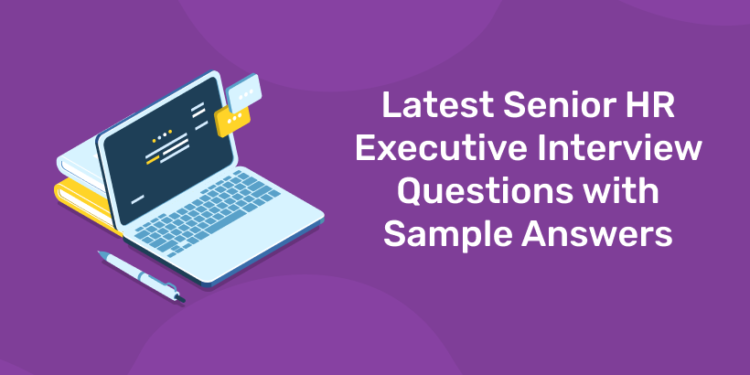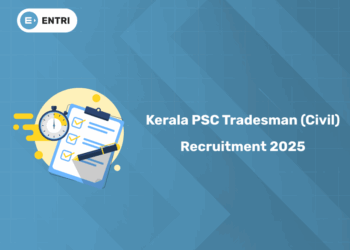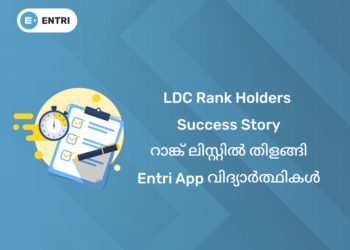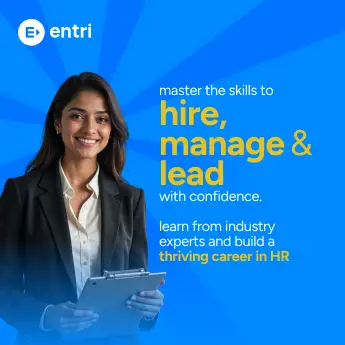Table of Contents
Introduction
Senior HR Executive Interview Questions with Sample Answers. The job market is so fluid, coupled with the pressure of having to navigate through the web of getting into the top level, such as that of a Senior HR Executive. Recruitment processes for these positions are demanding since the candidate must demonstrate not only technical knowledge but also leadership qualities, strategic thinking ability, and interpersonal skills. Since companies increasingly view effective human resource management as crucial for achieving business objectives, the demand for eligible HR leaders in the company system also rises. In this blog, we’ll share the latest questions for Senior HR Executive interviews with sample answers. We will give you tips to draft your answer and, further, why you should be continually learning as an HR professional – with courses such as the Entri HR Management Course.
Senior HR Executive Interview Questions with Sample Answers
Lets find out latest Senior HR Executive Interview Questions asked in recent interviews.
1. Describe your HR leadership style.
Sample Response:
“I would say that my leadership style is transformational. I work with my employees to create an environment of trust and empowerment. Clearly delineating vision and building open communication, I encourage my team to persevere towards excellence. Mentoring and developmental opportunities are extremely important to me to ensure that every member of the team gets time to grow and contribute their own worldview.”
2. How do you ensure compliance with labor laws and regulations?
Sample Answer:
“Compliance with labor laws is critical in HR. I stay updated through continuous education, attending workshops, and networking with HR professionals. I implement regular training sessions for my team to ensure everyone understands the current regulations. Additionally, I conduct compliance audits to identify and rectify any potential issues proactively.”
3. How do you handle conflicts between employees?
Sample Answer:
“I enter conflicts with a neutral, solution-focused mindset. First, I give each party the opportunity to be heard, so they feel understood. Then, I facilitate a discussion to find common ground and a resolution. This not only resolves the conflict but also equips employees with the skills to resolve conflicts in the future.”
4. What strategies do you use to improve employee engagement?
Sample Answer:
“I use several tactics to get employees more engaged, starting with annual surveys to determine what employees are thinking. Following that feedback, I then initiate programs such as recognition and professional development. Open communication is also encouraged by allowing employees a free-for-all discussion on ideas and concerns of which there would likely be. This, in my opinion, will create ownership and belonging.”
5. Tell me about a successful HR initiative you sponsored.
Example Response:
“I led a mentorship program that paired new hires with experienced employees. The initiative aimed to enhance onboarding and foster a sense of community. Within the first year, we noted a 25% decrease in turnover rates, and both mentors and mentees reported increased job satisfaction and productivity.”
6. How do you approach talent acquisition?
Sample Answer:
“My strategy for talent acquisition is multi-layered and strategic. I work with department heads to identify what they need and utilize various channels, such as social media and employee referrals, to find candidates. Having an applicant tracking system in place allows for process efficiencies, and we’re able to bring in the right people who share our culture and values.”
7. How do you measure the effectiveness of HR programs?
Example Answer:
“I measure the effectiveness of activities through KPIs that include turnover rates, training completion rates, and even employee satisfaction scores. Post-implementation reviews would help us ascertain the impact on organizational performance because of the initiations and thereby make data-driven decisions for strategies in the future,”
8. Tell me of a time you had to decide on an issue related to a particular employee.
Sample Answer:
“I faced the challenging decision of terminating a long-term employee who was underperforming. I conducted a thorough performance review, provided feedback, and offered opportunities for improvement. Ultimately, I prioritized the organization’s needs while ensuring the decision was fair and compassionate, supporting the employee through the transition.”
9. What role does technology play in HR management?
Sample Answer:
“Technology is at the core of contemporary HR management. It helps make more efficient work and saves administrative work by letting us focus on strategic initiatives. I use HR software for payroll, performance management, and recruitment. Data analytics can help identify trends and enable making the right decisions toward enhancing the general effectiveness of the HR system.”
10. How do you ensure and develop a great company culture?
Example Response:
“Developing a strong company culture begins with clear values and a mission statement. I promote these through team-building activities and recognition programs. Regular communication from leadership about the importance of our culture is crucial, and I encourage feedback from employees to ensure it evolves positively.”
11. How do you handle employee performance issues?
Sample Answer:
“When performance issues are found, I gather data and feedback for greater understanding of the situation. Then, I call that particular employee into a single-moment meeting to discuss his performance, and together we brainstorm the challenges he may be facing. Subsequently, with clear objectives and timelines, we implement a performance improvement plan that provides check-in to monitor progress.”
12. How do you administer employee surveys?
Example Response:
“I make use of a mix of online survey tools and focus groups in collecting employee feedback. Online surveys provide anonymity and thus honest answers, while the focus groups bring in more details on specific issues. I look at the data collected to pick trends and areas that need improvement and ensure the feedback is actually acted upon.”
13. What do you do to promote diversity and inclusion in the workplace?
Sample Answer:
“I promote diversity and inclusion by having a strategic recruitment approach to ensure the diversity of the candidate pool, unconscious bias training and cultural competency for all employees, and development of employee resource groups that can help bring the underrepresented groups together to form a community in the organization.”
14. How do you plan your workforce?
Example Answer:
” Working with department heads, our workforce strategy must align to organizational objectives; and through this, I can proactively identify and address talent gaps.”
15. What would you say about your experience with employee onboarding?
Example Response:
“I developed comprehensive onboarding programs that induct new hires into the culture and processes of the company. This includes formalized orientation processes, mentorship programs, and regular check-ins during the first few months of employment. I want to make sure new employees feel welcomed, informed, and prepared to succeed in their roles.”
16. How do you stay current with HR trends and best practices?
Example Response:
“I stay abreast of current trends in HR through industry publications, attendance of conferences, and participation in professional organizations. The networking opportunity through fellow HR professionals helps exchange ideas and learn from innovative practices. I also continuously invest in online courses and certifications.”
17. How do you handle workforce reductions or layoffs?
Sample Answer:
“Dealing with workforce layoffs is sensitive and transparent. I make sure we have a transparent process, talking to the affected employees about the reasons for this decision and letting them know about the support we can offer. I work with outplacement services to provide tools for job search and career coaching.”
18. How do you manage remote teams?
Sample Answer:
“Managing a remote team demands proper communication and trust. I have been using collaboration tools to ensure that there are regular check-ins and everyone feels connected in a team. Clear expectations for a performance and avenues for professional development are also critical in keeping a remote team engaged and productive.”
19. What’s your strategy on succession planning?
Sample Answer:
“I approach succession planning by identifying key positions within the organization and assessing potential internal candidates. I conduct talent reviews to evaluate skills and readiness, creating personalized development plans to prepare these individuals for future leadership roles. This proactive approach ensures a smooth transition when key roles become vacant.”
20. What is your experience with employee relations?
Sample Answer:
“I have ample experience in employee relations, involving the building of positive relationships among employees and the management. It ensures that the communication is always open, with regular feedback in place so that concerns are raised before they escalate into bigger problems. I facilitate conflict resolution as well as empower employees to constructively voice out their grievances.”
21. How do you assess training needs within the organization?
Sample Answer:
“I assess training needs through performance reviews, employee feedback, and skills gap analysis. I also collate information from department heads about specific areas of which training could improve productivity and engagement. This data-based approach ensures that our training programs are relevant and effective.”
22. How would you deal with sensitive employee information?
Sample Response:
“I treat employee confidential information with the utmost care and confidentiality. I ensure that only authorized personnel have access to this information and follow strict data protection policies. Regular training on confidentiality and data privacy is crucial for all HR staff to maintain compliance and trust.”
23. What strategies do you implement for talent retention?
Sample Answer:
“I make different retention strategies. I keep employees with a compensation package that will outcompete their peers; there are chances of growth and professional development, as well as good work environment. Good feedbacking sessions and award programs make people feel valued, and that improves the retention level.”
24. What strategy do you follow in respect to performance appraisal systems?
Example Response:
“My performance appraisals are collaborative and continuous. I support ongoing feedback rather than annual reviews. This includes clear objectives and regular checks in with employees to discuss their progress. I also make sure that the appraisal system is transparent and fair, incorporating employee input into the process.”
25. How do you manage a diverse workforce?
Sample Answer:
“I manage my diverse workforce with an inclusive culture where everyone feels valued. For this, I have diversity training, open cultures, and dialogues about all of their cultural differences. I also focus on policies that help maintain work-life balance, support all types of needs that would help every employee thrive in our organization.”
26. How do you measure the effectiveness of your HR team?
Sample Response:
“I judge the performance of my HR team based on performance indicators such as time-to-fill positions, scores of employee satisfaction, and retention rates. Moreover, feedbacks and performance reviews regularly conducted within the company allow me to review individual contributions as well as suggest areas of improvement.”
27. What is your strategy for handling difficult employees?
Sample Answer:
“My approach to dealing with problem employees is understanding the root cause of their behavior. I open a one-on-one discussion with them to get their perspective and try to find any underlying issues. Together, we create an improvement plan with clear expectations and provide them with support that will lead to positive change.”
28. How do you link HR strategies with business objectives?
Sample Response:
“I align HR strategies with business goals by working closely with senior leadership. I make sure that the initiatives of human resources support the overall mission and objectives of the organization. Periodic business performance metrics review makes us adjust our strategies as needed, so that it stays as a strategic partner to achieve business success.”
29. How do you create a learning culture?
Sample Answer:
“I foster a culture of lifelong learning by encouraging professional development through training programs, workshops, and mentorship. I also acknowledge and reward those employees seeking extra certifications or new skills because they are learning to grow for themselves and within our organization.”
30. How do you handle employee grievances?
Sample Answer:
“I address employee grievances by giving the employees a safe and confidential environment where they can voice their concerns. I listen attentively and make sure every grievance is handled promptly and justly. If a third party is involved, I invite them in such a manner that will bring about resolution while maintaining transparency throughout the whole process.”
31. How do you approach change management in HR?
Sample Answer:
“I come into change management with a very clear communication strategy to help the employees understand the reasons behind the change and the benefits. I get key stakeholders involved early on in the process to gather input and build support. Training and resources during the transition ensure that the employees are prepared and supported.”
32. How would you describe your experience with employee benefits programs?
Example Response:
“I have designed and administered various employee benefits programs, including health insurance, retirement plans, and wellness initiatives. I make sure that these programs are reviewed regularly to meet the needs of employees and remain competitive in the market. Continuous feedback from employees helps us enhance our offerings.”
33. How do you handle the onboarding process for remote employees?
Sample Answer:
“I manage remote onboarding through a structured virtual orientation program focused on company policies, culture, and resources. I make sure that new employees are matched with mentors who will guide and support them. In the first months, regular check-ins help resolve any challenges that may come as they settle into their roles.
34. How do you measure employee satisfaction?
Sample Answer:
“I gauge the satisfaction of my employees through constant surveys, focus groups, and individual check-ins. The data thus collected helps identify trends and areas that need improvement. I also support an open-door policy for the employees to share their concerns with me, which we address in a timely manner.”
35. How do you conduct compensation and benefits analysis?
Example Response:
“I approach compensation and benefits analysis by conducting market research to benchmark our offerings against industry standards. Regularly reviewing employee feedback helps us understand the effectiveness of our compensation strategy. I collaborate with finance to ensure our compensation packages align with budget constraints while remaining competitive.”
36. How do you handle training and development for employees?
Sample Answer:
“I manage training and development by conducting performance reviews to identify the skills of employees and areas of improvement. I then design individual development plans, which may include training through workshops, online courses, or mentorship. I review these plans regularly to ensure they are relevant and effective.”
37. How do you promote work-life balance within the organization?
Sample Answer:
“I would encourage work-life balance by arranging flexible work arrangement setups, like telecommuting and flexible hours. I will also encourage the taking of their full vacation days, providing stress management tools and wellness programs. A work-life balance culture leads to the enrichment of employee satisfaction and retention.”
38. How do you implement employee retention strategies?
Sample Response:
“I manage employee retention strategies by identifying the key drivers of turnover within the organization. This includes conducting exit interviews to gather insights from departing employees. Based on the data, I implement targeted initiatives such as career development opportunities and employee recognition programs to enhance job satisfaction.”
39. What experience do you have with HR metrics and analytics?
Sample Answer:
“I really have experience in utilizing human capital metrics and analytics to help influence data-driven decisions. I typically report on key measures such as turnover rate, time-to-fill for open positions, and employee satisfaction scores. Looking at all this data helps us see trends, measure the success of different programs we have in HR, and make the necessary adjustments accordingly.”
40. How do you make sure that your HR organization is aligned with the strategic direction of your business?
Sample Response:
“I ensure alignment by regularly engaging with senior leadership to understand the organization’s strategic goals. I communicate these goals to the HR team, ensuring that our initiatives support business objectives. Collaboration with other departments also helps us identify opportunities for HR to contribute to organizational success.”
These questions and answers will help you prepare for the Senior HR Executive interview, so you may understand how your experience and strategies can be put across effectively.
Become an HR Expert – Enroll in Our HR Management Course Today!
Unlock the secrets to effective Human Resource Management with our expert-led course! Learn recruitment, employee relations, performance management, and more to build a thriving workplace. Start your journey toward a successful HR career today!
Know MoreSenior HR Executive Interview Questions Tips
- Be Real: Authenticity works with interviewers. Share your own experiences and insights rather than generic answers.
- Research the Company: Know the company culture, values and recent news.
- Show Continuous Learning: Highlight your commitment to HR development. Mention relevant certifications, courses or workshops you’ve attended, like the HR Management Course by Entri.
Entri’s HR Management Course Features:
- 3 months, live and recorded sessions.
- Comprehensive Curriculum: Foundational HR, talent acquisition, performance management and more.
Invest in your education and boost your credentials and confidence and become a more attractive candidate in the market.
Conclusion of Senior HR Executive Interview Questions
Interviewing for a Senior HR Executive role requires a strategic approach, broad knowledge and the ability to articulate your experiences. By knowing the latest Senior HR Executive Interview Questions and practicing your answers, you’ll be a strong candidate for the role. And continuous learning and upskilling through courses like Entri’s HR Management Course will further boost your professional credentials.
Remember, the secret to any interview is preparation and authenticity. Go forth and show them your HR knowledge and passion and you’ll be there!
Become an HR Expert – Enroll in Our HR Management Course Today!
Unlock the secrets to effective Human Resource Management with our expert-led course! Learn recruitment, employee relations, performance management, and more to build a thriving workplace. Start your journey toward a successful HR career today!
Know MoreFrequently Asked Questions
What qualifications are needed to become a Senior HR Executive?
To become a Senior HR Executive, candidates typically need a bachelor’s degree in human resources, business administration, or a related field. Many organizations prefer candidates with a master’s degree in HR or an MBA. Additionally, relevant certifications such as SHRM-SCP, PHR, or CIPD can enhance your qualifications. Extensive experience in HR roles, particularly in leadership positions, is crucial. Skills in strategic planning, employee relations, compliance, and workforce management are also essential for success in this role.
What are the key responsibilities of a Senior HR Executive?
Senior HR Executives play a vital role in shaping organizational culture and strategy. Key responsibilities include:
- Strategic Planning: Collaborating with senior management to develop HR strategies that align with business objectives.
- Talent Management: Overseeing recruitment, onboarding, and retention strategies to build a skilled workforce.
- Employee Relations: Addressing employee concerns and conflicts, fostering a positive work environment.
- Compliance: Ensuring adherence to labor laws and regulations while implementing policies and procedures.
- Training and Development: Identifying training needs and overseeing professional development programs.
- Performance Management: Implementing performance appraisal systems and coaching managers on effective feedback and evaluation techniques.
How can I prepare for a Senior HR Executive interview?
Preparing for a Senior HR Executive interview involves several key steps:
- Research the Company: Understand the organization’s culture, values, and recent developments. This knowledge will help you tailor your responses.
- Review Common Interview Questions: Familiarize yourself with typical questions related to HR leadership, conflict resolution, and compliance.
- Prepare Your Experiences: Use the STAR method (Situation, Task, Action, Result) to structure your responses to behavioral questions, highlighting relevant experiences.
- Demonstrate Strategic Thinking: Be ready to discuss how you align HR strategies with business goals and the impact of your initiatives.
- Showcase Continuous Learning: Highlight any relevant certifications, courses, or workshops that demonstrate your commitment to professional development.
What role does technology play in modern HR management?
Technology is integral to modern HR management. It streamlines processes, enhances data accuracy, and improves communication. Key ways technology impacts HR include:
- Automation: HR software automates administrative tasks such as payroll, benefits management, and recruitment, freeing HR professionals to focus on strategic initiatives.
- Data Analytics: HR analytics tools provide insights into workforce trends, employee engagement, and turnover rates, helping organizations make informed decisions.
- Employee Self-Service: Technology enables employees to access their information, such as benefits and payroll details, reducing administrative burdens on HR.
- Remote Collaboration: Digital communication tools facilitate collaboration among remote teams, ensuring continued productivity and engagement.
How do I build a strong company culture as a Senior HR Executive?
Building a strong company culture involves several strategic initiatives:
- Define Core Values: Clearly articulate the organization’s core values and ensure they are communicated at all levels.
- Lead by Example: As a leader, demonstrate the behaviors and attitudes that reflect the desired culture.
- Encourage Open Communication: Foster an environment where employees feel comfortable sharing their ideas and concerns.
- Implement Recognition Programs: Acknowledge and reward employees for their contributions, reinforcing positive behaviors aligned with company values.
- Conduct Regular Surveys: Gather employee feedback to assess the culture and make necessary adjustments based on their input.
What strategies can be used to improve employee engagement?
Improving employee engagement is essential for productivity and retention. Effective strategies include:
- Regular Feedback: Implement a continuous feedback culture where employees receive constructive input on their performance.
- Professional Development Opportunities: Offer training programs, workshops, and mentorship to help employees grow in their careers.
- Recognition Programs: Establish systems for recognizing and rewarding employees for their hard work and achievements.
- Work-Life Balance Initiatives: Promote flexible work arrangements, wellness programs, and time-off policies to support employees’ personal lives.
- Open Communication Channels: Create forums for employees to share their thoughts and ideas with management, fostering a sense of belonging.
How do you measure the success of HR initiatives?
Measuring the success of HR initiatives requires clear metrics and benchmarks. Common methods include:
- Key Performance Indicators (KPIs): Track metrics such as turnover rates, time-to-fill positions, and employee satisfaction scores.
- Surveys and Feedback: Conduct regular employee surveys to gauge satisfaction and engagement levels.
- Performance Reviews: Assess the impact of training and development programs through performance evaluations.
- Benchmarking: Compare HR metrics against industry standards to identify areas for improvement.
- Return on Investment (ROI): Evaluate the financial impact of HR initiatives by measuring their contributions to overall business performance.
What challenges do Senior HR Executives face today?
Senior HR Executives face several challenges in today’s dynamic workplace:
- Talent Acquisition: Competing for top talent in a tight labor market requires innovative recruitment strategies.
- Employee Retention: High turnover rates can be costly, necessitating effective retention strategies.
- Compliance: Keeping up with changing labor laws and regulations is crucial to avoid legal issues.
- Diversity and Inclusion: Creating a diverse workforce and fostering an inclusive environment remains a priority for many organizations.
- Technological Advancements: Adapting to new HR technologies and ensuring the workforce is equipped with necessary digital skills is an ongoing challenge.
How important is continuous learning in HR?
Continuous learning is vital in HR due to the evolving nature of the field. Regularly updating skills and knowledge helps HR professionals:
- Stay Current: Keeping abreast of the latest trends, laws, and technologies ensures that HR practices remain relevant and effective.
- Enhance Skills: Ongoing education allows professionals to develop new competencies that can improve their performance and career prospects.
- Drive Innovation: Learning encourages HR leaders to adopt innovative strategies and practices that can benefit the organization.
- Adapt to Change: The ability to learn quickly is crucial in responding to changes in the workforce and business environment.
What resources are available for aspiring Senior HR Executives?
Aspiring Senior HR Executives can access various resources to enhance their knowledge and skills:
- Professional Organizations: Joining organizations like SHRM or CIPD offers networking opportunities and access to industry resources.
- Online Courses: Platforms like Entri provide specialized HR courses that cover essential skills and competencies.
- Webinars and Conferences: Attending industry events allows professionals to learn from experts and stay updated on trends.
- Books and Publications: Reading HR-related books, journals, and articles can provide valuable insights and best practices.
- Mentorship Programs: Seeking mentorship from experienced HR leaders can offer guidance and support in career development.









